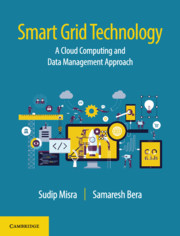Book contents
- Frontmatter
- dedication
- Contents
- Figures
- Tables
- Foreword
- Preface
- Part I Introduction
- Part II Cloud Computing Applications for Smart Grid
- 5 Demand Response
- 6 Geographical Load-Balancing
- 7 Dynamic Pricing
- 8 Virtual Power Plant
- 9 Advanced Metering Infrastructure
- 10 Cloud-Based Security and Privacy
- Part III Smart Grid Data Management and Applications
- Part IV Smart Grid Design and Deployment
- Index
8 - Virtual Power Plant
from Part II - Cloud Computing Applications for Smart Grid
Published online by Cambridge University Press: 20 October 2018
- Frontmatter
- dedication
- Contents
- Figures
- Tables
- Foreword
- Preface
- Part I Introduction
- Part II Cloud Computing Applications for Smart Grid
- 5 Demand Response
- 6 Geographical Load-Balancing
- 7 Dynamic Pricing
- 8 Virtual Power Plant
- 9 Advanced Metering Infrastructure
- 10 Cloud-Based Security and Privacy
- Part III Smart Grid Data Management and Applications
- Part IV Smart Grid Design and Deployment
- Index
Summary
In a smart grid, distributed energy generators are expected to play an important role in providing cost-effective and green energy-services to customers. Implementation of wind farms and solar panels are two popular distributed energy generating sources. In addition to this, combined heat power (CHP) and fuel cells are also expected to take part in the distributed energy generation process. However, due to the intermittent behavior of such distributed generators, maintaining reliable energy-services to customers is a big challenge for service providers. Additionally, energy generation from the distributed energy sources are environment dependent. Therefore, it may not be cost-effective if more energy is generated during off-peak periods. Consequently, it is required to have some kind of storage devices that can store energy on a situation basis (i.e., during off-peak hours), and can discharge energy to the distribution side during on-peak hours. In order to meet these requirements, a dynamic energy consumption/distribution platform, called virtual power plant (VPP), is considered.
Concept of Virtual Power Plant
A virtual power plant (VPP) is conceptualized as a combination of different distributed energy resources (DERs). Therefore, VPP can be considered a decentralized energy resource system with a large number of small-scale DERs such as solar energy, wind energy, CHPs, fuel cells, and plug-in hybrid electric vehicles (PHEVs). Consequently, it creates a single energy monitoring profile, while considering different parameters characterizing each distributed energy source. Figure 8.1 shows a schematic diagram of a virtual power plant consisting of different energy resources. As a whole, a VPP is capable of providing reliable and cost-effective energy supply to customers. Additionally, a large-scale VPP can be formed with a combination of different small-scale VPPs, as shown in Figure 8.2. Depending on various characteristics, there are two types of VPP – commercial and technical – that will be discussed in this section.
Commercial VPP
The concept of a commercial virtual power plant (CVPP) is used for energy trading in energy markets. With the integration of CVPP, energy-market risks can be reduced in order to utilize the distributed energy resources. Consequently, individual DER can benefit from an intelligent market in order to maximize its own revenue. A conceptual view of the commercial virtual power plant (CVPP) is shown in Figure 8.3. The operation of a CVPP consists of three phases – input, CVPP operation, and output. Depending on different inputs, CVPP optimizes revenue from individual DERs and offers different services.
- Type
- Chapter
- Information
- Smart Grid TechnologyA Cloud Computing and Data Management Approach, pp. 106 - 117Publisher: Cambridge University PressPrint publication year: 2018



